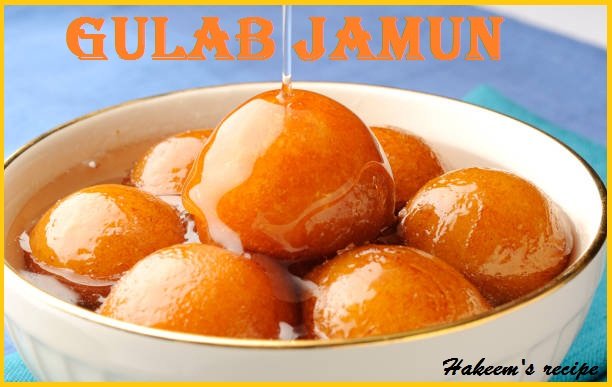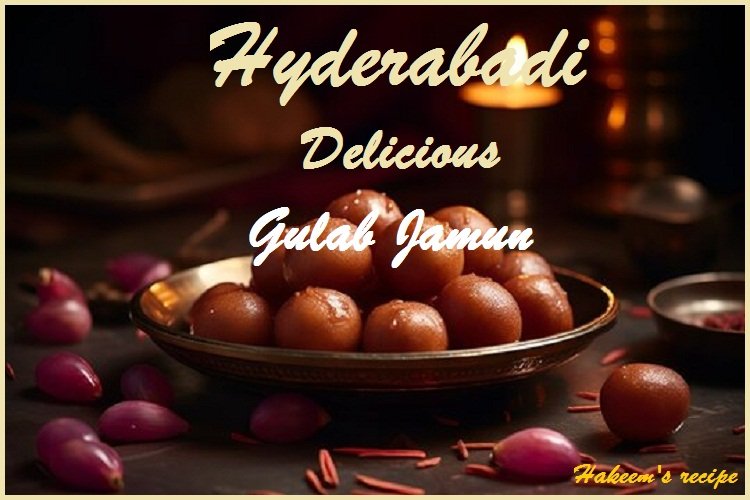
Make Perfect Hyderabadi Gulab Jamun: Introduction
Gulab Jamun is a classic Indian dessert loved by people of all ages. The Hyderabadi version of Gulab Jamun is known for its unique flavor and texture. This guide will take you through the process of making delicious Hyderabadi Gulab Jamun at home. Let’s dive into the world of sweets and learn how to make these mouthwatering treats.
Chapter 1: Ingredients You’ll Need
To make Hyderabadi Gulab Jamun, you’ll need the following ingredients:
For the Jamun:
1 cup milk powder
1/4 cup all-purpose flour (maida)
1/4 teaspoon baking soda
2 tablespoons ghee (clarified butter)
1/4 cup milk (more if needed)
For the Sugar Syrup:
2 cups sugar
1.5 cups water
4-5 green cardamom pods, slightly crushed
A few strands of saffron (optional)
1 teaspoon rose water or kewra water
Chapter 2: Preparing the Dough
Mix Dry Ingredients: In a large bowl, combine milk powder, all-purpose flour, and baking soda.
Add Ghee: Add ghee to the dry mixture and mix well until it resembles breadcrumbs.
Form the Dough: Gradually add milk and knead the mixture to form soft, smooth dough. The dough should have a balanced texture, neither too sticky nor too dry.
Rest the Dough: Cover the dough with a damp cloth and let it rest for about 10-15 minutes.
Chapter 3: Making the Sugar Syrup
Combine Ingredients: In a large saucepan, combine sugar, water, and cardamom pods.
Boil the Syrup: Bring the mixture to a boil over medium heat, stirring occasionally until the sugar dissolves completely.
Add Flavor: Add saffron strands and rose water (or kewra water) to the syrup. Simmer for a few minutes, then remove from heat and set aside.
Chapter 4: Shaping the Jamuns
Divide the Dough: Divide the dough into small, equal-sized portions and roll them into smooth balls. Ensure there are no cracks on the surface.
Shape the Jamuns: You can keep the traditional round shape or give them an elongated oval shape, which is also popular in Hyderabadi Gulab Jamun.
Chapter 5: Frying the Jamuns
Heat the Oil: In a deep frying pan, heat oil over medium-low heat. The oil should be hot, but it shouldn’t reach the point of smoking.Test the Temperature: Drop a small piece of dough into the oil. If it rises to the surface gradually and without changing color quickly, the oil is ready.
Fry the Jamuns: Gently slide the dough balls into the oil. Fry them on low heat, turning occasionally, until they turn golden brown on all sides. This should take about 6-8 minutes.

Chapter 6: Soaking in Sugar Syrup
Transfer to Syrup: Remove the fried jamuns from the oil and drain excess oil. Transfer them immediately to the warm sugar syrup.Soak Properly: Let the jamuns soak in the syrup for at least 2-3 hours. This allows them to absorb the syrup and become juicy.
Chapter 7: Serving Suggestions
Garnish: Garnish the Hyderabadi Gulab Jamun with chopped nuts like pistachios or almonds for an extra touch of elegance.
Serve warm or cold: Serve the Gulab Jamun warm or chilled, depending on your preference.
Chapter 8: Tips for Perfect Gulab Jamun
Kneading the Dough: Ensure the dough is smooth and crack-free for perfectly shaped jamuns.
Frying Temperature: Fry the jamuns on low heat to ensure they cook evenly and absorb the syrup well.
Sugar Syrup Consistency: The sugar syrup should be warm and not too thick or too thin for optimal absorption.
Chapter 9: Common Mistakes to Avoid
Cracked Dough: Cracked dough balls can lead to uneven frying and syrup absorption. Knead the dough well and roll smooth balls.
High Heat Frying: Frying on high heat can cause the jamuns to cook quickly on the outside but remain raw inside.
Cold Syrup: Always transfer the fried jamuns to warm syrup for better absorption.
Chapter 10: Experimenting with Flavors
Flavor Variations: Experiment with flavors by adding a dash of cinnamon, nutmeg, or cardamom powder to the dough.
Stuffed Jamuns: Try stuffing the jamuns with chopped nuts or a small piece of chocolate for a delightful surprise.
Conclusion
Making Hyderabadi Gulab Jamun at home is a rewarding experience that allows you to enjoy this classic dessert fresh and customized to your taste. Follow this guide to create soft, juicy, and delicious Gulab Jamun that will impress your family and friends. Happy cooking!
Chapter 11: Storage and Shelf Life
Storing Gulab Jamun:
Room Temperature: If you plan to consume the Gulab Jamun within a day, you can store them at room temperature. Store them in an airtight container to keep them fresh. Refrigeration: For longer storage, place the Gulab Jamun in an airtight container and refrigerate. When stored this way, they can last up to a week. Before serving; you can warm them slightly to enhance their taste and texture.
Freezing Gulab Jamun:
Freezing Method: To freeze Gulab Jamun, place them in a single layer on a baking sheet and freeze until solid. After freezing, transfer them to a freezer-safe container or bag. They can be stored in the freezer for up to 3 months.Thawing: To thaw frozen Gulab Jamun, move them to the refrigerator for several hours or overnight. Before serving, warm them gently in a microwave or over the stovetop to restore their softness and juiciness.
Chapter 12: Nutritional Information
Calorie Count: A typical serving of Gulab Jamun contains approximately 150-200 calories, depending on the size and ingredients used.
Macronutrients:
Carbohydrates: Gulab Jamun is high in carbohydrates due to the sugar syrup and dough ingredients.
Protein: The milk powder in the dough provides a modest amount of protein.
Fat: The ghee and frying oil contribute to the fat content in Gulab Jamun.
Considerations: While Gulab Jamun is a delightful treat, it is best enjoyed in moderation, especially for those watching their calorie or sugar intake.
Chapter 13: Variations of Gulab Jamun
Kala Jamun: A darker, denser version of Gulab Jamun, often flavored with additional spices and dried fruits.
Paneer Gulab Jamun: Made with fresh paneer (Indian cottage cheese), this version is softer and has a unique texture.
Bread Gulab Jamun: Quick and easy variation using bread slices instead of traditional dough, suitable for those who need a quick fix.
Chapter 14: Cultural Significance
Festive Celebrations: Gulab Jamun is a staple in Indian festivities, including Diwali, Eid, and weddings. It is often served as a symbol of sweetness and joy.
Family Traditions: Many families have their own recipes and methods for making Gulab Jamun, passed down through generations. Making Gulab Jamun can be a bonding activity that brings families together.

Chapter 15: Serving Ideas
With Ice Cream: Serve Gulab Jamun warm with a scoop of vanilla ice cream for a delightful contrast of temperatures and textures.
With Rabri: Pair Gulab Jamun with creamy rabri (thickened sweetened milk) for an indulgent dessert.
As a Gift: Homemade Gulab Jamun makes for a thoughtful and delicious gift during festive seasons and special occasions.
Chapter 16: Troubleshooting Common Issues
Hard Jamuns: If your Gulab Jamun turns out hard, it might be due to over-kneading the dough or frying at too high a temperature. Ensure the dough is soft and fry on low heat.
Cracked Jamuns: Cracks can form if the dough is too dry. Add a little more milk while kneading to achieve a smooth consistency.
Syrup Absorption: If the Jamuns do not absorb the syrup well, ensure the syrup is warm and the jamuns are added immediately after frying.
Chapter 17: Healthier Alternatives
Baked Gulab Jamun: For a healthier version, try baking the Gulab Jamun instead of frying. They may have a different texture but can still be delicious.
Low-Sugar Syrup: Use less sugar or a sugar substitute to make the syrup for a lower-calorie treat.
Whole Wheat Flour: Substitute part of the all-purpose flour with whole wheat flour for a slightly healthier dough.
Chapter 18: Fun Facts
Origin: Gulab Jamun is believed to have originated in Persia and was brought to India during the Mughal era.
Name Meaning: The name “Gulab Jamun” comes from the Persian words “Gulab” (rose) referring to the rose-flavored syrup, and “Jamun” (a type of Indian fruit that the dessert resembles).
World Records: The largest Gulab Jamun ever made weighed over 55 kg (121 lbs) and was created in India in 2015.
Chapter 19: Frequently Asked Questions
Can I use store-bought Gulab Jamun mix?
Yes, store-bought mixes can be a convenient option, though making from scratch often provides a fresher taste.
Why did my Gulab Jamun dissolve in oil?
This could be due to too much baking soda in the dough. Ensure to measure ingredients accurately.
Can I use condensed milk instead of milk powder?
Yes, you can, but the texture might change slightly.
Adjust the flour and liquid ratio accordingly.
Chapter 20: Conclusion
Making Hyderabadi Gulab Jamun at home is a delightful and rewarding experience. With this comprehensive guide, you have all the steps and tips needed to create perfect, juicy, and delicious Gulab Jamun. Whether for a festive occasion or a sweet treat to enjoy with family, these Gulab Jamun are sure to impress. Happy cooking!










